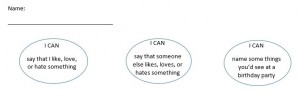
When I first heard about the exit ticket, I thought it was a great idea. It seemed like a way to keep myself accountable to assess every student, and it seemed like a way to keep students accountable to do something to show me they’d learned what I’d taught. It also seemed like a decent classroom management tool – if you didn’t pay attention and do the exit ticket task, you couldn’t leave.
My problem with the exit ticket developed as I began to understand how much I should be focusing on long-term memory and not short-term memory if I truly cared more about life-long learning and less about the grade on the vocab quiz on Friday. Soon I couldn’t reconcile the two ideas; how could I say that any student, even the best, most attentive student, could do anything with the language if they’d just heard the concept? The fact is, I can’t tell you when that student will be able to perform a given task from their long-term memory, where it really counts. So I killed the exit ticket.
But really, you don’t have to. Doesn’t it seem this is the way it is with almost any idea? If you don’t evaluate the principle behind the activity, it often spirals in to a very bad idea. But when you keep your language learning principles in mind you can usually tweak any idea to make it very good. Here are four potential alternatives to the traditional exit ticket.
-
Stamp sheets
If you haven’t seen what Megan and Kara of the Creative Language Class blog and their colleagues are doing with stamp sheets, you should check it out. Basically, students have a sheet that organizes, in circles for example, the I Can statements for their current unit. As students progress and can accomplish the tasks on the sheet, the teacher stamps that circle. My idea was to try this as an exit ticket. When I got the chance to teach Spanish 1 at the recent Camp Musicuentos event, I used a smaller version with I Can statements which were the three goals of my lesson plan. I was able to talk to many students, but not all, to verify that they could do what I was asking them to do. This accomplished several goals and gave me some tips for you:
– If you have to show daily progress and/or give a daily grade, this is a perfect way to get that.
– Use it to make sure you’re hearing from every student on every goal. In one class I only spoke with about 1/4 of the students, in the other, almost all. So I knew exactly whom I needed to speak to the next day. Also, if a student can’t accomplish the goal, simply don’t accept the paper. If you don’t have a student’s sheet, you know that student still needs to work on it.
– Use it for the goals in the class period, just like an exit ticket, but don’t look at it as something you can check off and say “Ok, my kids can do that, now on to something else.” If you have a goal on the sheet that you’ve just taught, fine, but remind yourself that all you’re assessing is if students were paying attention today, not whether they’ll be able to do this next week. You know what they’ll need to be able to do that, too – lots of practice between now and then!
– Repeat and build on previous stamp sheets in order to check their unit stamp sheet. I thought, if my student can use le gusta to tell me what a classmate likes today, and then I repeat that same stamp in three days, and again twice next week, then I’m more hopeful that they actually can do it and I can go ahead and stamp the same goal on their unit sheet.
-
Positive reflection
In a recent #langchat that inspired this post, Colleen offered a tip that I absolutely loved. I think it’s my favorite overhaul of the exit ticket. Instead of pretending that students can typically acquire useful language within one class period, how about shifting the emphasis to how they feel about what they did in the class period? Colleen suggests that we have students wrap up the class with some reflective self-reporting: “Today I was proud that I…” By making students reflect in this way, you’ll force them to think about their intrinsic motivation and their successes instead of things that went wrong. Did I mention I LOVE THIS IDEA?!
-
Timed free write
Mira’s suggestion was to have students do a timed free write. I’m envisioning this as a 3-minute closing activity in which students write anything about anything. Only requirements are that it has to be in the target language. Who knows what they’ll come up with? You could offer a photograph or a story beginning as inspiration.
-
Something old & something new
To really tweak the problem of the exit ticket, simply use it to assimilate the old with the new instead of pretending you’re actually assessing what you just taught. If you worked on prepositions last week, and you’re working on house vocabulary today, show a picture and ask students to say where something is: “The book is on the table. The lamp is next to the sofa.” Recycle in a new context and that’s some memory-boosting exit ticket! An added benefit here is that you’ll learn which of your students are struggling with an “old” skill and may need you to refocus on it.
What are your suggestions for how to make the exit ticket better reflect our goal of fostering long-term memory?
12 Comments
Comments are closed.





These are great ideas! My favorite exit ticket is my Semáforo with sticky notes. Students write name/date/period on the sticky notes with proof of understanding if they totally “get it” (stick it on the green light), a question that they still have if they are a little confused (stick it on the yellow light), and nothing but name/date/period if they are completely lost (stick it on red). Many times students think they get it, so they stick their “proof” on green, but when I read them I realize they have something mixed up. This gives me another opportunity to go back and clear up confusion.
Thanks for sharing all of these!
What an awesome idea, Courtney!
These are all good ideas and an important reminder we are aiming for long-term acquisition, not short term memorization. I have used a variety of “exit tickets” over the years. Since the brain (and the teacher) crave novelty, I like to switch it up. I was much better last year about having students reflect on each class period with different prompts. I found it powerful even thought it was difficult not “teach” up to the bell. It taught me the importance of students taking time to process. I’m also a fan of a quick google form “exit ticket” so I can more easily organize the results and share them back w/ my students. I love the variety of question types so the assessment can be quick and often fun with cool images. One thing I’ve been meaning to try this year is the “entry ticket” because I’d like the ability to provide immediate and timely feedback. Gracias for sharing.
Oh, Google Forms is an AWESOME idea for those in a 1:1 situation! Thanks! And I will definitely have to think more about an “entry ticket” – if it works well you should consider presenting about it at a conference (guest blogging it here??) 😉
Some great ideas! Love this post.
We work with preschool kids.
Give kids a stamp on their hand, or a sticker as they leave as they say goodbye in Spanish, or the expression of the day or for answering a question that reaches for language taught previously. Customize these for each student — with 3 options in mind — with a hug or high five available for the most timid.
For kids who aren’t quite verbal yet, an increased one-on-one connection builds confidence.
pina madera
http://www.singalingo.com
Sarah–
Sorry for that weird title on my last post…auto fill went berzerk. Feel free to edit it or avisame, and I”ll take care of reposting it. Really like your blog post. Some simple, creative ideas to support teaching!
Piña
No problem, thanks for contributing ideas. 🙂
Good idea. I’ll let you know. I’m giving it a go tomorrow.
Can’t wait to hear about it.
These are wonderful ideas that I can’t wait to put into place for next school year. I was observed by a lead Science teacher this year. He took off points from my evaluation because I didn’t use an exit ticket. 🙁 I was so mad! He didn’t use my 3-tiered review game for the reflexives as an assessment tool.
In my Spanish 2 class, I had the students get into groups of 3. One student picked up a card with the name of the item (espejo) and then had to go get the correct item from a box. The second student needed to write on the board the verb associated with the item (mirarse). The third person’s job was to create a sentence using the name of the item and the verb associated with it, plus give extra information (siempre, por la mañana, lentamente, etc.).
After each group did it three times, I added twists to the game! On one round, I told them they had to use an infinitive. On another round I had them use a gerund. They had to use the different placements of the pronoun. The students had to rotate jobs within the group. I observed and saw which teams/students were having difficulty with the tasks.
But, alas, it wasn’t an exit ticket and the lead teacher couldn’t see how I possibly could have known which of my students knew what. He said that I should have had each student write on the exit ticket all three steps on a card so that I knew who learned what from the review game.
It’s such a common mistake schools make to have non-WL teachers do observations on WL teachers!
[…] or you want students to reflect on how they feel about what they learned in class in a type of reflective exit ticket, there can be a lot of value in that. The value evaporates when we try to say that we’re […]